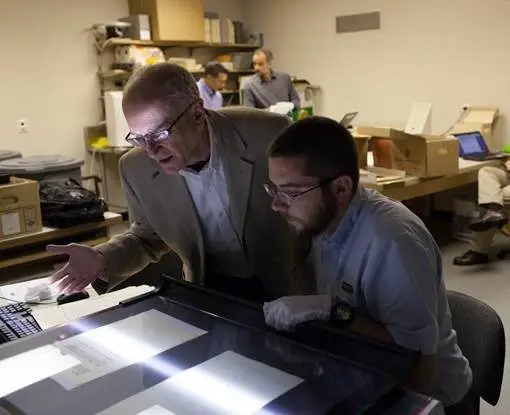Scanning the Rosenberg Diary Under Armed Guard

For Kris Sheckels, a Crowley imaging specialist and project manager, this past November 7th will be a day to discuss with the grand kids. Only 25 now, he knows he’ll never forget scanning the long-missing Alfred Rosenberg Diary for the United States Holocaust Memorial Museum (USHMM). In Delaware. On a borrowed scanner. Under armed guard.
THE PATH TO DELAWARE
This Wednesday, in a formal ceremony, the USHMM took possession of the Rosenberg Diary when it was transferred into their custody by U.S. Immigration and Customs Enforcement (ICE). The diary held the handwritten thoughts and ideologies of Alfred Rosenberg, one of the most notorious members of the Third Reich and of the Nazi Party during World War II. The historical document was seized by ICE Homeland Security Investigations (HSI) special agents in Wilmington, Del. following seven decades, a 17-year search spurred by USHMM senior advisor on archives Henry Mayer and an extensive ICE investigation.
How the document – a set of loose papers noted as “handwritten diary notes” when seized by the allied forces in 1945 – came to be in Delaware is a story of mystery and intrigue that covers Germany, Pennsylvania and New York and includes a Nazi war leader, a German-born American lawyer, the lawyer’s secretary and a professor. For different accounts, simply search the web for “The Rosenberg Diary.”
Last year, in November 2012, the U.S. Attorney’s Office for the District of Delaware and HSI special agents received information from an art security specialist about the possible location of the diary, which was found, verified and seized as evidence.
Meghan Wyatt, a business development specialist at Crowley who has collaborated with the USHMM digital collections staff and archivists on several projects over the years, received a call to be on stand-by for a possible last-minute digitization of the diary. In October of this year, she got the call that the diary would soon be transferred to USHMM and that there was a small window of opportunity to digitize the diary while in ICE custody so that the document could be put online simultaneously with the transfer.
Could Crowley come to Delaware?
SCANNING IN PLACE
“Things quickly fell in line,” says Wyatt. “It just happened that we were on-site scanning a project for client Adam Matthew Digital (AMD) at Hagley Museum and Library in Wilmington, DE and had a Zeutschel 12000 Advanced planetary book scanner on location. AMD and the Hagley very generously allowed us to interrupt their project so that we could use our scanner for a one-day digitization of the Rosenberg Diary. This was both fortuitous and cost-effective as the diary was unable to leave the State.”
Scanner operator selection was easy, she said. “We asked Kris Sheckels to head to Delaware. He’s a very experienced scanner operator and project manager and has the added benefit of a technical support background. His abilities meant that we could send our best and be able to easily mitigate any issues that might arise in either the digitization process or with the equipment.”
SCANNING UNDER LOCK AND KEY
When Sheckels arrived, he was immediately greeted and identified by USHMM staff. “It was like a scene out of a movie,” remembers Kris. “It was raining and a black SUV pulled up. Two special agents – fully-armed with badges swinging and ICE slickers on – hopped out of the vehicle and carried a brown box marked ‘EVIDENCE.’ They clearly took this job and the diary seriously, as did the USHMM staff.”
Once inside, the pages were handled by USHMM historian Jürgen Mätthäus in conjunction with ICE agents. As the chief translator, Mätthäus had the responsibility to ensure that the pages were in the correct order for scanning. Initially, both he and Sheckels used white gloves to handle the papers, a standard practice for rare materials. “As it turned out,” says Sheckels, “it proved more difficult to grasp each page with the gloves on and we found that the material received less handling when we took our gloves off. Sometimes archivists are concerned about transferring oils or smudges from hands to the original, but in this case it was a judgment call that the material would fare better with less handling.” He smiles, “My hands were clean, I swear.”
With a digital archivist on one shoulder and two armed ICE special agents near the other, Sheckels scanned more than 400 pages from 9 a.m. until 4 p.m. with very few breaks. “The timeline was tight, but the material was so interesting that the time flew,” he said. “The [USHMM] director of digital collections, Michael Levy, took the time to point out interesting facts about the diary as I was scanning and was also there to help answer technical questions. Some of the diary was written on what appeared to be scrap paper, such as the back of Nazi stationary, and we were able to determine on the spot the most authentic way to scan the image because Michael was there.”
When asked what he was thinking throughout the day, Sheckels pauses. “I kept thinking, ‘Where have these notes been? Who else has touched them?’ I couldn’t read them, of course, but I wanted to know what each page said. As I scanned, I was able to get a feel for Rosenberg’s mood of the entry by the flow of the ink or the pressure of his pen. Throughout the day, it became easier to tell when he was writing with passion or when he was upset with something.” Additionally, he says “I just had an eerie sense. Not of evil, but a sense of the ‘realness’ of this diary…the coffee stains, the different papers used…things like that. To know that I was touching a document of the inner thoughts of someone who had a huge effect on the world in a negative sense was a little disconcerting.” Sheckels said that he did some quick research on Rosenberg prior to scanning the diary.
The pages of the diary were scanned as 300 dpi uncompressed TIFF files. Notes Wyatt, “We used a color scanner to preserve the authenticity of the document. Scanning in color showed the age and color of the paper and was as close to an exact replication of the original as you can get.” You can find the full diary online thanks to the efforts of USHMM digital collection developer Paul Ruderman. The diary is seen in its native German; an English translation will follow at some point in the future.
THE HISTORIC IMPORTANCE OF THE ROSENBERG DIARY
The diary confirms Alfred Rosenberg’s role as a “shaper of Nazi ideology,” noted USHMM director Sara Bloomfield at the ceremony. She added that collecting remaining Holocaust artifacts is a “race against time” and each piece found helps to answer the question “why and how in an advanced society can this happen?”
While it will take historians some time to understand the importance of this find, Mätthäus said in his comments at the transfer ceremony that although the diary was “muted on crucial topics such as self-evident Nazi principles,” that in context with other such material “it’s a piece of the puzzle.” He added that “It’s not a smoking gun or a silver bullet” but aids in the big picture. What he found striking, he said, was Rosenberg’s “reflections and disillusionment at being sidelined. He blamed the individuals and not the system…never connecting the dots.”
The mission of the United States Holocaust Memorial Museum is to ensure that we, as another “advanced society” do connect the dots to ensure that history does not repeat. In such a noble cause, The Crowley Company is honored to have played an infinitesimally small part.
Questions about digitizing for preservation or wider access?
If you have any questions about preserving history through digitization, please contact The Crowley Company by calling (240) 215-0224. General inquiries can be emailed to [email protected]. You can also follow The Crowley Company on Facebook, Twitter, Google+, LinkedIn, Pinterest, and YouTube.
Author

